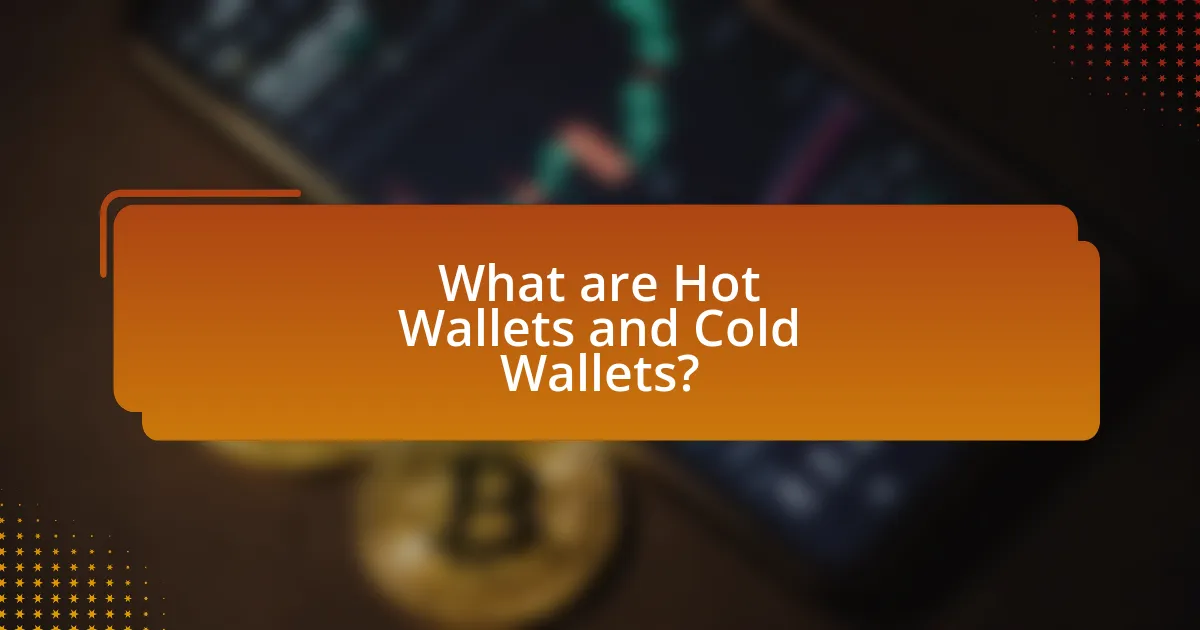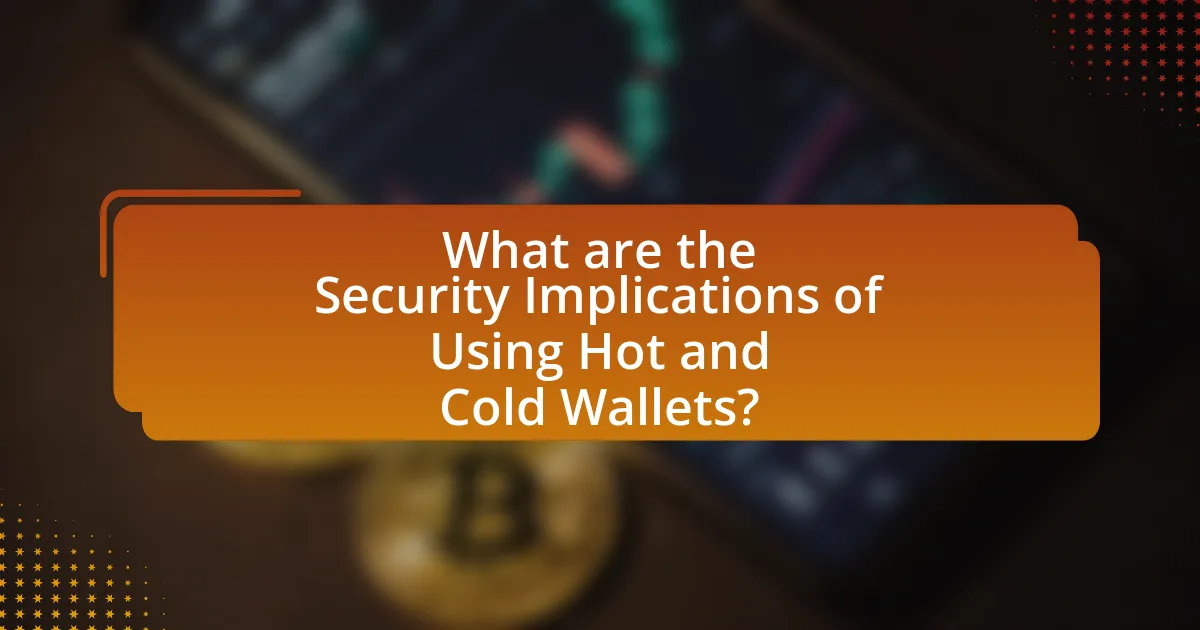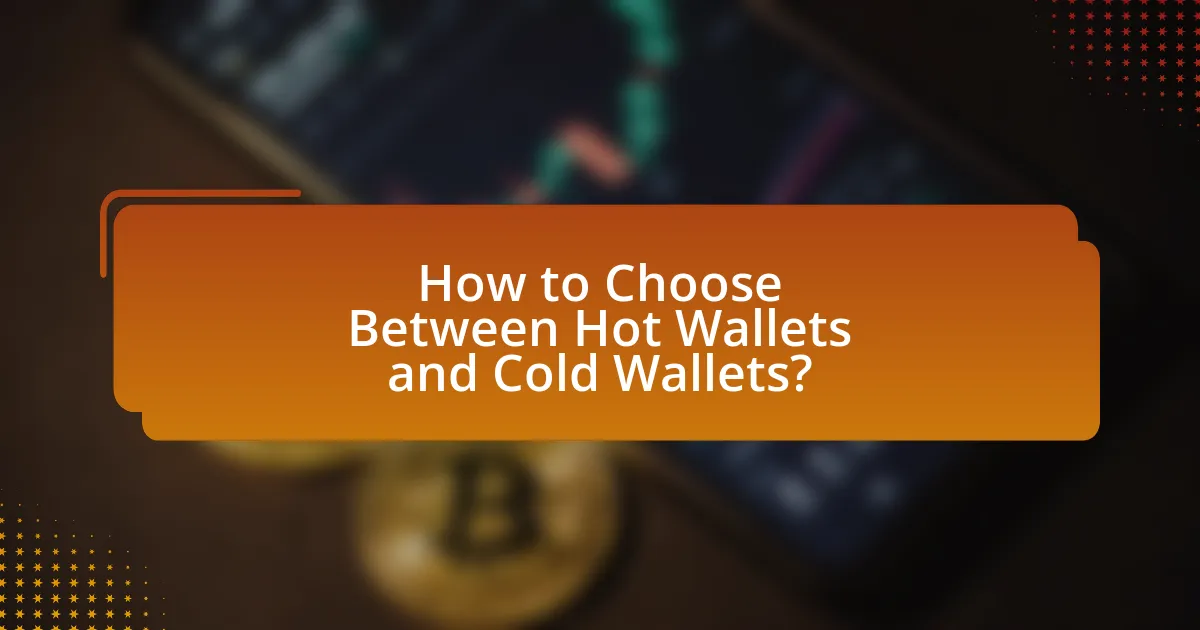The article compares hot wallets and cold wallets, two primary types of cryptocurrency storage solutions, focusing on their security implications. Hot wallets, which are internet-connected, offer convenience for transactions but are more susceptible to hacking and cyber threats. In contrast, cold wallets provide enhanced security by storing cryptocurrencies offline, making them ideal for long-term asset protection. The article discusses the functionality, features, and types of both wallet types, as well as the security risks associated with hot wallets and the best practices for managing both wallet types effectively. It emphasizes the importance of user needs and the amount of cryptocurrency held in determining the appropriate wallet choice.

What are Hot Wallets and Cold Wallets?
Hot wallets are digital wallets that are connected to the internet, allowing for quick and easy access to cryptocurrencies for transactions. They are typically used for everyday trading and spending due to their convenience, but this connectivity makes them more vulnerable to hacking and cyber attacks. In contrast, cold wallets are offline storage solutions for cryptocurrencies, such as hardware wallets or paper wallets, which provide enhanced security by keeping private keys disconnected from the internet. This offline status significantly reduces the risk of unauthorized access, making cold wallets a safer option for long-term storage of digital assets.
How do Hot Wallets function in cryptocurrency management?
Hot wallets function in cryptocurrency management by providing a digital interface for users to store, send, and receive cryptocurrencies while being connected to the internet. This connectivity allows for quick transactions and easy access to funds, making hot wallets ideal for frequent trading or everyday use. However, their online nature also exposes them to higher security risks, such as hacking and phishing attacks. According to a report by CipherTrace, in 2020 alone, over $1.9 billion was lost to cryptocurrency theft, much of which involved hot wallets. This highlights the trade-off between convenience and security in cryptocurrency management.
What are the key features of Hot Wallets?
Hot wallets are digital wallets that are connected to the internet, allowing for quick and easy access to cryptocurrencies. Key features of hot wallets include user-friendly interfaces, instant transaction capabilities, and compatibility with various devices such as smartphones and computers. Additionally, hot wallets often support multiple cryptocurrencies, making them versatile for users. However, their constant internet connection makes them more vulnerable to hacking and cyber attacks, which is a critical consideration for security.
What types of Hot Wallets are available?
There are several types of hot wallets available, including web wallets, mobile wallets, and desktop wallets. Web wallets are accessible through internet browsers and often provided by exchanges, allowing users to manage their cryptocurrencies online. Mobile wallets are applications installed on smartphones, offering convenience for on-the-go transactions. Desktop wallets are software programs downloaded to personal computers, providing users with more control over their private keys while still being connected to the internet. Each type of hot wallet serves different user needs, balancing accessibility with varying levels of security.
What are the characteristics of Cold Wallets?
Cold wallets are characterized by their offline storage of cryptocurrencies, which enhances security against hacking and online threats. They typically come in the form of hardware devices or paper wallets, ensuring that private keys are not exposed to the internet. This offline nature significantly reduces the risk of unauthorized access, making cold wallets a preferred choice for long-term storage of digital assets. Additionally, cold wallets often require physical access to the device or paper to conduct transactions, further safeguarding the assets from remote attacks.
How do Cold Wallets differ from Hot Wallets?
Cold wallets differ from hot wallets primarily in their connectivity to the internet; cold wallets are offline storage solutions, while hot wallets are connected to the internet. Cold wallets, such as hardware wallets or paper wallets, provide enhanced security against online threats, making them ideal for long-term storage of cryptocurrencies. In contrast, hot wallets, which include web and mobile wallets, offer greater convenience for frequent transactions but are more vulnerable to hacking and cyber attacks due to their online nature. This distinction highlights the trade-off between security and accessibility in cryptocurrency storage options.
What are the main types of Cold Wallets?
The main types of cold wallets are hardware wallets and paper wallets. Hardware wallets are physical devices that securely store private keys offline, making them resistant to online hacking attempts. Examples include devices like Ledger and Trezor, which have built-in security features to protect against unauthorized access. Paper wallets, on the other hand, involve printing the private keys and public addresses on paper, which can be stored securely but are vulnerable to physical damage or loss. Both types of cold wallets provide enhanced security compared to hot wallets, as they are not connected to the internet, significantly reducing the risk of cyber threats.

What are the Security Implications of Using Hot and Cold Wallets?
Hot wallets are connected to the internet and are more vulnerable to hacking, while cold wallets are offline and provide enhanced security against cyber threats. The use of hot wallets facilitates quick transactions but exposes users to risks such as phishing attacks and malware, as evidenced by numerous incidents where exchanges have been hacked, resulting in significant losses. In contrast, cold wallets, which store cryptocurrencies offline, significantly reduce the risk of unauthorized access, making them a preferred choice for long-term storage. According to a report by Chainalysis, over $1.9 billion was stolen from hot wallets in 2020 alone, highlighting the security risks associated with their use. Therefore, the choice between hot and cold wallets directly impacts the security of cryptocurrency holdings.
Why are Hot Wallets considered less secure?
Hot wallets are considered less secure because they are connected to the internet, making them vulnerable to hacking and cyber attacks. This constant online connectivity exposes the private keys and sensitive information stored within hot wallets to potential threats, as evidenced by numerous high-profile breaches in the cryptocurrency space. For instance, in 2019, the cryptocurrency exchange Binance suffered a hack that resulted in the loss of over $40 million worth of Bitcoin, highlighting the risks associated with online storage solutions.
What vulnerabilities do Hot Wallets face?
Hot wallets face several vulnerabilities primarily due to their constant connection to the internet, making them susceptible to hacking, phishing attacks, and malware. These wallets store private keys online, which can be targeted by cybercriminals. For instance, in 2020, the KuCoin exchange suffered a hack that resulted in the loss of over $280 million worth of cryptocurrencies, highlighting the risks associated with hot wallets. Additionally, users may inadvertently expose their wallets to risks through insecure networks or by falling victim to social engineering tactics.
How can users mitigate risks associated with Hot Wallets?
Users can mitigate risks associated with Hot Wallets by implementing strong security measures such as enabling two-factor authentication (2FA), regularly updating software, and using unique, complex passwords. Two-factor authentication adds an extra layer of security, making unauthorized access more difficult. Regular software updates ensure that users benefit from the latest security patches, reducing vulnerabilities. Additionally, using unique passwords minimizes the risk of credential theft. According to a report by the Cybersecurity & Infrastructure Security Agency, employing these practices significantly decreases the likelihood of successful cyberattacks on digital wallets.
What makes Cold Wallets a more secure option?
Cold wallets are a more secure option because they store cryptocurrencies offline, significantly reducing the risk of hacking. Unlike hot wallets, which are connected to the internet and vulnerable to cyber attacks, cold wallets, such as hardware wallets or paper wallets, keep private keys away from online threats. This offline storage method has been proven effective, as evidenced by the fact that major security breaches in the cryptocurrency space have predominantly targeted online wallets. Additionally, cold wallets require physical access to the device or paper, further enhancing security against unauthorized access.
How do Cold Wallets protect against hacking and theft?
Cold wallets protect against hacking and theft by storing cryptocurrencies offline, which eliminates exposure to online threats. Unlike hot wallets, which are connected to the internet and vulnerable to cyberattacks, cold wallets, such as hardware wallets or paper wallets, keep private keys secure in a physical format. This offline storage method significantly reduces the risk of unauthorized access, as hackers cannot reach the assets without physical possession of the cold wallet. Additionally, cold wallets often incorporate security features like encryption and PIN protection, further enhancing their defense against theft.
What are the limitations of Cold Wallets in terms of accessibility?
Cold wallets have significant limitations in terms of accessibility, primarily due to their offline nature. This offline status means that users cannot access their funds quickly or easily, as transactions require physical access to the wallet device, such as a USB drive or hardware wallet. Additionally, cold wallets often necessitate a more complex setup process, which can deter less tech-savvy users. The requirement for physical security also means that if the wallet is lost or damaged, recovery can be challenging, leading to potential loss of funds. These factors collectively contribute to the limited accessibility of cold wallets compared to hot wallets, which allow for immediate access and easier transaction capabilities.

How to Choose Between Hot Wallets and Cold Wallets?
To choose between hot wallets and cold wallets, assess your needs for accessibility versus security. Hot wallets, which are connected to the internet, offer quick access for frequent transactions but are more vulnerable to hacking. In contrast, cold wallets, which store cryptocurrencies offline, provide enhanced security against online threats but are less convenient for immediate use. According to a report by the Blockchain Research Institute, cold wallets are recommended for long-term storage of significant amounts of cryptocurrency due to their lower risk of theft. Therefore, if you prioritize security and plan to hold assets long-term, opt for a cold wallet; if you need regular access for trading, a hot wallet may be more suitable.
What factors should be considered when selecting a wallet type?
When selecting a wallet type, factors such as security, accessibility, and intended use must be considered. Security is paramount; cold wallets, which store assets offline, provide enhanced protection against hacking, while hot wallets, connected to the internet, offer convenience for frequent transactions. Accessibility is crucial as well; hot wallets allow quick access to funds, making them suitable for active trading, whereas cold wallets are better for long-term storage. Additionally, the intended use influences the choice; users who prioritize security for large holdings may prefer cold wallets, while those needing regular access might opt for hot wallets.
How do user needs influence the choice between Hot and Cold Wallets?
User needs significantly influence the choice between Hot and Cold Wallets based on factors such as accessibility, security, and transaction frequency. Users requiring quick access to their cryptocurrencies for frequent transactions typically prefer Hot Wallets, which are connected to the internet and offer convenience. In contrast, users prioritizing security for long-term storage often opt for Cold Wallets, which are offline and less vulnerable to hacking. According to a survey by the Cambridge Centre for Alternative Finance, 40% of cryptocurrency users prefer Hot Wallets for their ease of use, while 60% of those holding assets long-term choose Cold Wallets for enhanced security. This data illustrates how user needs directly shape wallet selection based on their specific use cases.
What role does the amount of cryptocurrency held play in this decision?
The amount of cryptocurrency held significantly influences the decision between using hot wallets and cold wallets. Individuals or entities with substantial cryptocurrency holdings are more likely to opt for cold wallets due to their enhanced security features, which protect against online threats. For instance, cold wallets, such as hardware wallets, store cryptocurrencies offline, making them less vulnerable to hacking attempts that often target hot wallets connected to the internet. According to a report by Chainalysis, in 2021, over $3.2 billion was stolen from hot wallets, underscoring the risks associated with online storage. Therefore, the larger the cryptocurrency amount, the greater the incentive to prioritize security through cold wallet solutions.
What best practices can enhance wallet security?
To enhance wallet security, users should implement multi-factor authentication (MFA), utilize strong, unique passwords, and regularly update software. Multi-factor authentication adds an extra layer of protection by requiring additional verification beyond just a password, significantly reducing the risk of unauthorized access. Strong, unique passwords prevent easy guessing or brute-force attacks, while regular software updates ensure that any security vulnerabilities are patched promptly. According to a study by the Cybersecurity & Infrastructure Security Agency, using MFA can block 99.9% of automated attacks, highlighting its effectiveness in enhancing security.
How can users effectively manage their Hot and Cold Wallets?
Users can effectively manage their Hot and Cold Wallets by implementing a clear strategy that includes using Hot Wallets for daily transactions and Cold Wallets for long-term storage. Hot Wallets, which are connected to the internet, should be used for small amounts of cryptocurrency to facilitate quick access and transactions, while Cold Wallets, which are offline, should store the majority of assets securely to protect against online threats.
To reinforce this approach, data from the 2021 Chainalysis report indicates that over 90% of cryptocurrency thefts occur from Hot Wallets, highlighting the importance of limiting exposure in these wallets. Additionally, utilizing multi-signature features and regularly updating security protocols can further enhance the management of both types of wallets.
What are common mistakes to avoid when using cryptocurrency wallets?
Common mistakes to avoid when using cryptocurrency wallets include neglecting to enable two-factor authentication, failing to back up wallet recovery phrases, and using weak passwords. Enabling two-factor authentication significantly enhances security by requiring a second form of verification, which can prevent unauthorized access. Not backing up recovery phrases can lead to irreversible loss of funds if the wallet is lost or damaged, as these phrases are essential for wallet recovery. Additionally, weak passwords make wallets vulnerable to hacking; using strong, unique passwords is crucial for protecting assets. According to a report by the Cybersecurity & Infrastructure Security Agency, 81% of data breaches are linked to weak or stolen passwords, underscoring the importance of robust password practices in cryptocurrency security.


